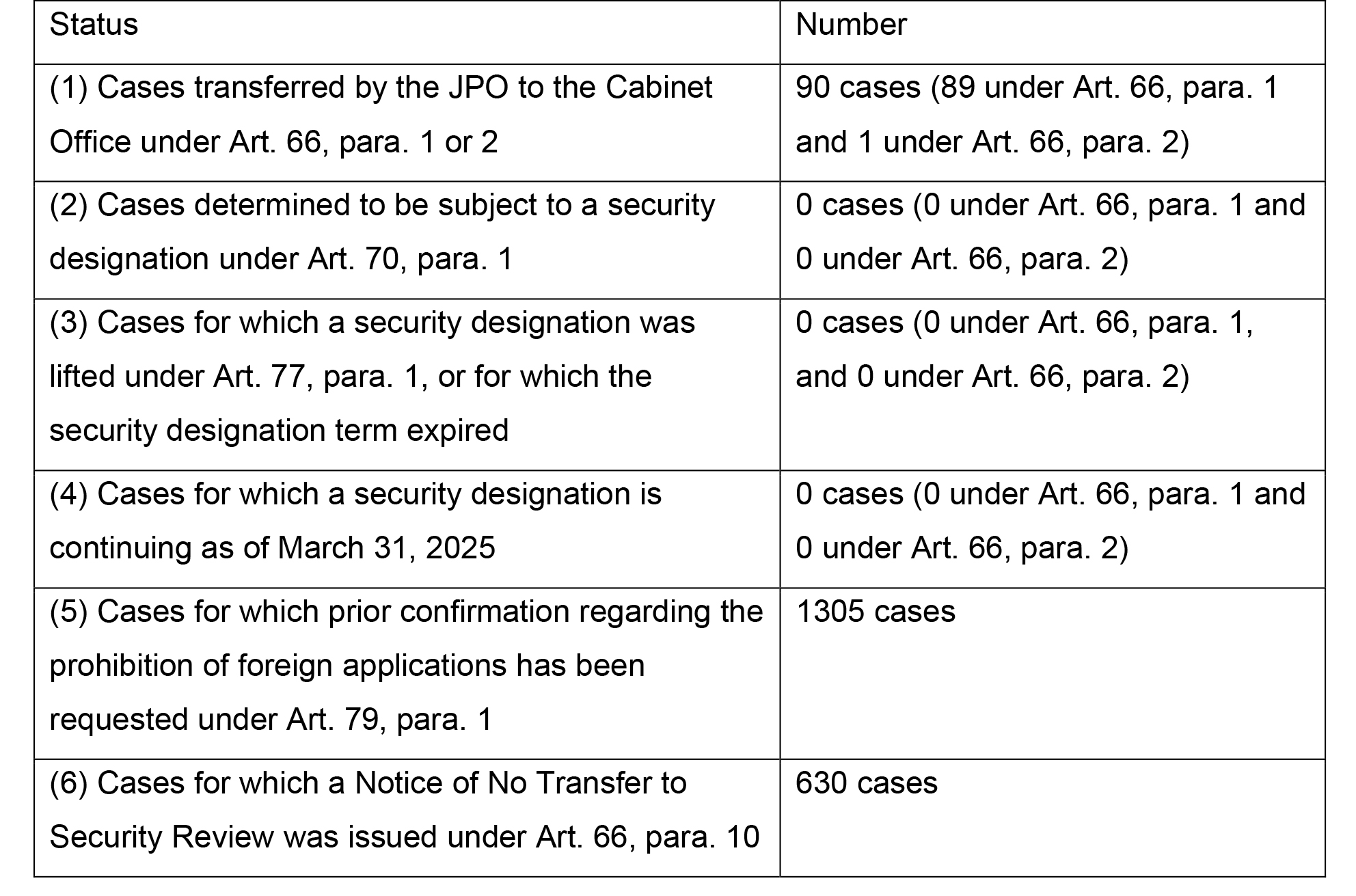Year one of the Patent Non-Disclosure System in Japan
25 Jul 2025 | Newsletter
More than a year has passed since Japan implemented the system of non-disclosure of patent applications and the system of prohibition of filing foreign applications on 1 May 2024, under the Economic Security Promotion Act (hereinafter the “Act”). Recently, the Cabinet Office and the Japan Patent Office (JPO) issued an official summary of the system’s implementation status for the fiscal year of 2024 (from May 2024 to March 2025; this system came into force on 1st May of 2024.).
Patent Non-Disclosure System
The patent non-disclosure system involves a two-stage examination process, firstly by the JPO (Primary Review) and then by the Cabinet Office (Security Review).
In the Primary Review, the JPO reviews patent applications filed at the JPO to identify those with inventions falling under “Specified Technology Fields”, which are defined based on the International Patent Classification (IPC) system (Article 66, paragraph 1 of the Act). Japanese national phase entry applications of PCT applications are not subject to the Primary Review (Article 66, paragraph 5 of the Act). The JPO transfers a patent application selected by the Primary Review to the Cabinet Office for the Security Review within 3 months from the filing date (Article 66, paragraph 1 of the Act). Alternatively, when the applicant files a request for the Security Review of the application to, the JPO transfers it to the Cabinet Office without the Primary Review (Article 66, paragraph 2 of the Act). For a patent application to be transferred to the Cabinet Office, the JPO issues a Notice of Transfer to Security Review to the applicant (Article 66, paragraph 3 of the Act). For a patent application not transferred to the Cabinet Office, the JPO issues a Notice of No Transfer to Security Review, only upon the applicant’s request (Article 66, paragraph 10 of the Act).
In the Security Review, the Cabinet Office reviews patent applications transferred from the JPO to determine if they describe any sensitive inventions that, if made known to the public, would be highly likely to create a situation to undermine Japan’s security (Article 67, paragraph 1 of the Act). When such a sensitive invention is found, the Cabinet Office determines whether the application describing the sensitive invention should be subject to a security designation (Article 67, paragraph 1 of the Act). If the Cabinet Office decides to security-designate an invention, it issues a Notice of Security Designation to the applicant identifying the invention to be security-designated (Article 70, paragraph 1 of the Act) and specifying the security designation term. Conversely, if the Cabinet Office decides not to make a security designation, it issues a Notice of No Security Designation to the applicant (Article 71 of the Act) and returns the application to the JPO for normal processing.
If an invention described in a patent application is subject to security designation, then the security designation term starts when the Notice of Security Designation is issued and ends when the Notice of Termination of Security Designation is issued. During the security designation term, the application is subject to several restrictions. These include prohibitions on abandoning or withdrawing the application, implementing the invention without permission from the Cabinet Office, and disclosing the invention without a justifiable reason (Article 74, paragraph 1 of the Act). The Cabinet Office issues a Notice of Termination of Security Designation (i) when it lifts the security designation (Article 77, paragraph 1 of the Act) or (ii) when the term of the security designation expires without an extension (Article 77, paragraph 2 of the Act).
Foreign Application Prohibition System
If an invention was invented in Japan, has not been publicly disclosed, and is subject to a Security Review by the Cabinet Office if filed in Japan, regardless of whether it was invented or co-invented by a non-Japanese resident, then a patent application with the invention must not be filed in other jurisdictions before being filed in Japan (prohibition of foreign filing; Article 78, paragraph 1, the body, of the Act).
When a person or entity intends to file a foreign patent application for an invention that may be subject to the prohibition of foreign applications, he/she may request prior confirmation from the JPO (Article 79, paragraph 1 of the Act).
Overview of Year One of Patent Non-Disclosure System
The Cabinet Office and the JPO issued an official summary of the implementation status for the period from May 2024 to March 2025. The statistics are summarized as follows:

More than 1,300 requests for prior confirmation of the prohibition of foreign applications were filed with the JPO. This indicates that many entities are concerned about violating the prohibition. Conversely, only 90 cases were transferred from the JPO to the Cabinet Office for the Security Review, and no Security Designations were made during the first year. These numbers are much lower than expected, especially considering that the JPO designated many IPCs as Specified Technology Fields. Although the reasons for these low numbers are unclear, some applicants would intentionally avoid indicating these IPCs when filing patent applications. These statistics suggest that the JPO and the Cabinet Office are exercising caution during the Primary and Security Reviews, respectively. However, we have to wait and see how the implementation status of the system changes, because the statistics above are obtained in the period of less than one year after the system started.
Relevant links:
“System for Non-Disclosure of Patent Applications,” JPO website:
https://www.jpo.go.jp/e/system/patent/shutugan/patent_applications.html
